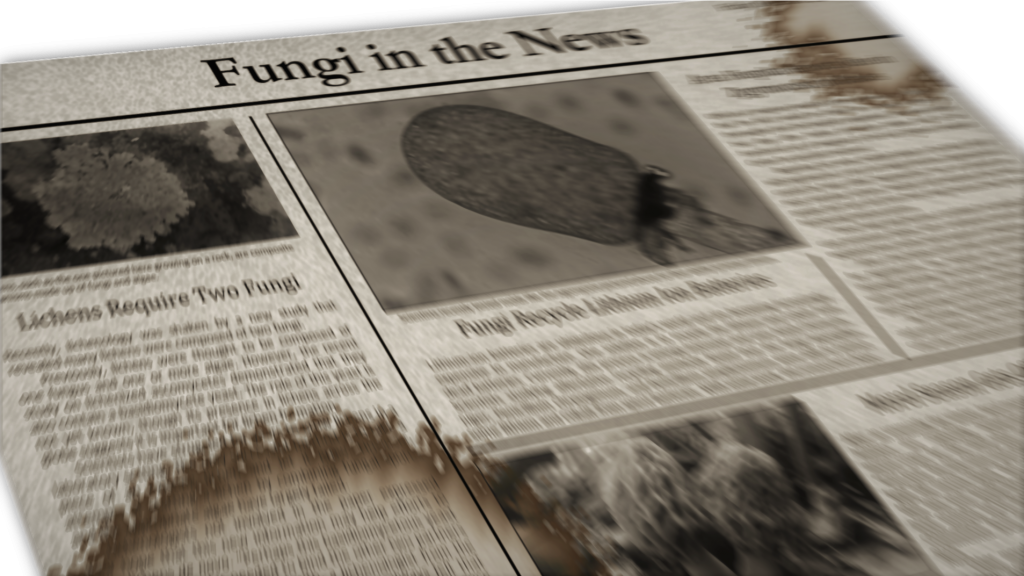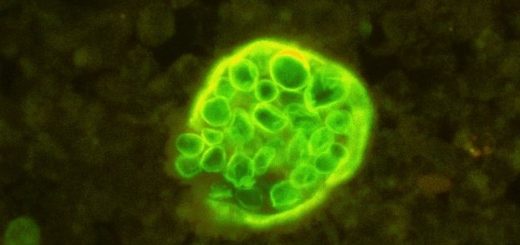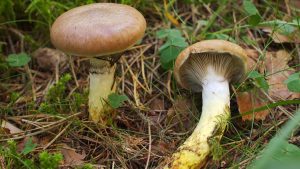2017 Summer News Update

Fungi appear in the news with surprising frequency. However, many of those stories do not provide any new information. Below is a summary of what we’ve learned about fungi from May through early July 2017. Read below to learn about: early fungal fossils, fungal epigenetics, the best way to cook mushrooms, liver disease, malaria, and more! Visit the associated links to get the full story.
With the growing concern over untrustworthy news sources and the media’s tendency to inaccurately report scientific studies, can these sources be trusted? Yes they can, with a bit of caution. I have checked to make sure all the articles based on scientific papers draw from peer-reviewed journals and that they accurately reflect the content of the papers. For articles not linked to scientific papers, I try to stick to sources with a good track record in reporting on science or to local sources for region-specific information. However, I encourage you to do your own research and decide for yourself whether these sources are trustworthy.
Early Fossils May Upend Fungal Evolution Theories
Fossilized remains of what scientists think are early fungi were recently unearthed in South Africa. The microscopic organisms were found in gas bubbles that formed in lava deep undersea 2.4 billion years ago. If confirmed as fungi, these new fossils push back the earliest example of fungi in the fossil record by over one billion years. Additionally, they suggest that fungi first evolved deep underwater rather than evolving on land or in shallow water, as was previously assumed. However, scientists have yet to definitively confirm that the fossils are fungi. Although the tiny threads look like mycelium, they could have been formed by another branch of early eukaryotes or by giant bacteria. Read more at: http://www.bbc.com/news/ science-environment-39656089
Fungal Gene Expression Heavily Reliant on DNA Modification
In the first analysis of its kind in fungi, researchers at the United States Department of Energy Joint Genome Institute assessed epigenetic modifications in 16 fungal genomes. Epigenetic modifications are chemical changes to the structure of DNA that allow organisms to store extra information. This study focused on a modification known as ‘6mA’, where a methyl group (CH3) is added to an adenine base (adenine is one of the four bases that make up the genetic code). The researchers found 6mA modifications were clustered around promoter regions of DNA, which are areas that tell cellular machinery where to start reading the genetic code. 6mA clusters were present at the beginnings of very active genes, indicating that the modification helps increase gene activity. The researchers were amazed at how often the 6mA modifications appeared in the fungal genome; as many as 2.8% of all adenine bases had the modification. Most organisms use it much more sparingly. Until this study, the highest known level of 6mA in a genome was 0.4%. The 16 fungi studied belonged to early diverging fungal lineages and are theoretically most similar to ancient fungi. Therefore, it is likely that most fungi use 6mA in similar ways. Understanding how fungi use epigenetic modifications like 6mA could improve efficiency in biotechnology based on fungi. Read more at: https://phys.org/news/2017-05-major-gene-fungi.html
Microwave or Grill Mushrooms to Increase Antioxidants
Scientists at the Mushroom Technological Research Center of La Rioja in Spain determined that mushrooms should be microwaved or grilled to retain more health benefits. The study examined how well various ways of cooking common cultivated mushrooms retained antioxidants and beneficial carbohydrates and proteins. When the mushrooms were fried in oil or boiled in water many of the beneficial compounds were removed from the mushroom by the liquid. This may not be a problem if you are making a soup, but makes a difference if you are planning to eat just the mushrooms. The one exception to this general trend was that boiling increased the glucans in the mushrooms. Microwaving or grilling the mushrooms, on the other hand, kept the beneficial compounds sealed inside the mushrooms. The researchers noted that adding a small amount of olive oil while grilling actually added antioxidants. Read more at: http://www.bbc.com/news/health-39998669
Gut Fungi Worsen Alcoholic Liver Disease
New research from the University of California San Diego School of Medicine and the J. Craig Venter Institute used a mouse model to demonstrate that gut fungi can worsen alcohol-related liver disease. Previous studies have shown that gut bacteria play a role in exacerbating alcohol-related liver disease, but this was the first paper to do so with fungi. Mice with long-term exposure to alcohol were found to have very high levels of fungi in their guts. This caused beta-glucan, a compound found in fungal cell walls, to enter the blood stream. Once the beta-glucan traveled to the liver, it triggered an immune response that caused inflammation in the liver. Inflammation kills liver cells, which worsens disease symptoms and ultimately leads to death. Importantly, the researchers were able to prevent the mice from developing alcohol-related liver disease by using an antifungal to kill the fungi in their guts.
To determine whether their results were relevant to humans, the scientists assessed number and variety of gut fungi in humans with alcohol-related liver disease. The researchers discovered that people with the disease had an overabundance of fungi in their guts that was dominated by Candida spp., some of which can be pathogenic. Furthermore, the authors found that a larger overpopulation of fungi was correlated with a higher mortality rate. The human part of this study was conducted with only a small group, so the authors encouraged further trials to corroborate and refine the data. The authors hope that better understanding how microbial gut communities impact alcohol-related liver disease will help develop new treatments for the disease. Read more at: https://health.ucsd.edu/news/releases/Pages/2017-05-22-intestinal-fungi-worsen-alcoholic-liver-disease.aspx
Engineered Fungi Fight Malaria
In studies conducted in Burkina Faso, scientists have tested the ability of genetically engineered fungi to kill mosquitos that can transmit malaria. For their study, the researchers selected the fungus Metarhizium pingshaensei, which naturally infects mosquitos but is harmless to other animals. The researchers inserted a toxic gene into the fungus to improve its ability to kill its host. Various toxins were trialed, including one from a scorpion and a few from spiders. These toxins attack the mosquito’s nervous system and prevent it from feeding before it dies. This means that once the mosquito is infected it will not be able to spread the malaria parasite while it remains alive. In the Burkina Faso trials, the researchers found that their engineered fungi could kill their mosquito hosts in a few days even if the mosquito only contacted a single spore. The researchers will now consult with local governments and residents to determine the best way to use the modified fungi. One possible method of deploying the fungi is to smear the spores onto mosquito nets. Read more at: http://www.newsweek.com/malaria-africa-genetic-engineering-625697
Snake Fungal Disease Found in Europe
Snake fungal disease (SFD, FFF#127) – a disease caused by the fungus Ophidiomyces ophiodiicola and threatening many snake species in eastern North America – was recently discovered in Europe. Researchers from the Zoological Society of London and the United States Geological Survey reviewed samples from wild snakes in the United Kingdom and Poland that were collected between 2010 and 2016. In at least one sample from each country, the researchers found evidence of both SFD and O. ophiodiicola. However, the strain was different than the one infecting North American snakes. It is possible that SFD has been in Europe for a long time and that European snakes are resistant to the disease. The researchers hope that differences between the European and American strains of the fungus will help scientists understand how SFD and resistance to the disease work. Read more at: https://www.usgs.gov/news/snake-fungal-disease-identified-wild-british-snakes-first-time
Fungus Halts Connecticut Gypsy Moths
Gypsy moths are one of the most visible invasive species in the eastern United States. Their caterpillars have voracious appetites and defoliate large swaths of land very quickly. Thankfully, they are easily kept in check by predators and diseases, including a fungus called Entomophaga maimaiga. Since they were introduced to the United States in 1869, their population has cyclically expanded and contracted due to their natural enemies. Last year, Connecticut and Rhode Island were hit hard by gypsy moths. At that time, the fungus had little impact on gypsy moth numbers but produced lots of spores. This year, the gypsy moth population was also large, but the fungal spores were in place and managed to kill about 90% of the caterpillars once significant rain fell in mid-July (rain activates E. maimaiga’s spores). Read more at: http://www.thewesterlysun.com/news/richmondhopkinton/10572714-154/fungus-decimates-gypsy-moth-population.html, http://www.nbcconnecticut.com/news/local/Maimaiga-Fungus-431030363.html, and https://www.na.fs.fed.us/spfo/pubs/fidls/gypsymoth/gypsy.htm
NASA Studies Mycobiome During Simulated Space Travel
In a recent experiment, the National Aeronautics and Space Administration confined four people to a simulated extraterrestrial settlement for a month. During this time, researchers also monitored changes to the mycobiome – the fungi that naturally live in the environment. At the end of the experiment, they found that the total number of fungi had decreased, but that certain fungi had actually increased their numbers. These fungi include species that have the potential to impair respiration or cause infection in people with weaker immune systems. Long term space travel tends to weaken the immune system, so any future mission to another planet will need to consider ways to deal with an increasingly hostile mycobiome. The relatively short study did not have time to witness any appreciable impacts of the new mycobiome on either the people involved or their equipment, so the real significance of these changes remains unknown. Read more at: http://www.smithsonianmag.com/smart-news/fighting-space-fungus-180964017/ and https://www.cnet.com/news/nasa-fungus-mycobiome-international-space-station-moon-mars-colony-astronauts/

![#119: Pisolithus arrhizus, the Dyeball [Archived]](https://www.fungusfactfriday.com/wp-content/themes/hueman/assets/front/img/thumb-medium-empty.png)






![#011: Characteristics of Kingdom Fungi [Archived]](https://www.fungusfactfriday.com/wp-content/themes/hueman/assets/front/img/thumb-small-empty.png)


Curious if beta glucan causing inflammation liver cells is problematic only in alcohol related illness, as someone told me they had non alcoholic liver problem (forget if cirrhosis). They had a tire all the time.